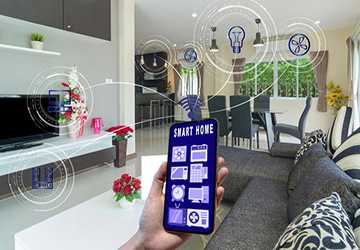In recent years, we've seen a remarkable shift in how we approach work and education. This change has been primarily driven by technological advancements and unexpected global circumstances, leading to a rise in remote work and online learning. As an increasing number of individuals find themselves transitioning to home-based work or study, it's essential to establish a conducive environment that promotes efficiency and learning. This article aims to provide valuable insights on effectively setting up your home for remote work and online learning. By following these practical tips, you can ensure that you can benefit from these experiences fully.

Section 1: Setting Up a Dedicated Workspace
One of the critical challenges of remote work and virtual learning is maintaining focus and separating personal life from professional or academic responsibilities. Setting up a dedicated workspace within your home is essential to address this issue.
l Choose the Right Location: Select a quiet and well-lit area in your home that is free from distractions. Ideally, this should be a separate room, but consider partitioning a corner to create your workspace if space is limited.
l Ergonomic Furniture: Invest in ergonomic furniture such as an adjustable chair and a desk at the right height. Proper ergonomics are crucial to preventing backaches, neck strains, and other physical discomforts from prolonged sitting.
l Organize Your Workspace: Keep your workspace organized and clutter-free. Storage solutions like shelves, drawers, and file organizers are used to maintain order. A clean and tidy workspace can reduce stress and increase productivity.
l Personalize Your Space: Add personal touches to make your workspace inviting. Decorate with plants, artwork, or other items that inspire you. A comfortable and aesthetically pleasing environment can boost creativity and motivation.
Section 2: Ensuring a Stable Internet Connection
A stable internet connection is the lifeline of remote work and virtual learning. A poor connection can lead to frustrating disruptions and reduced productivity. Here's how to optimize your internet setup:
l High-Speed Internet: Upgrade to a high-speed internet plan to ensure smooth video conferencing, fast downloads, and seamless online collaboration. Consult your internet service provider for the best plan that suits your needs.
l Wi-Fi Router Placement: Position your Wi-Fi router centrally in your home to maximize coverage. Avoid placing it in a corner or behind obstacles like walls and furniture. Consider using Wi-Fi range extenders if necessary.
l Hardwired Connections: For tasks that require a highly stable connection, such as video conferences or large file transfers, consider using an Ethernet cable instead of relying solely on Wi-Fi.
l Network Security: Secure your network with a strong password and encryption to protect sensitive data from potential cyber threats.
Section 3: Investing in the Right Technology
Having the right technology tools at your disposal can significantly enhance your remote work and virtual learning experience. Here are some recommendations:
l Up-to-date Computer: Ensure your computer is up-to-date and capable of handling the tasks required for your work or studies. Regularly update your software and hardware to maintain peak performance.
l Quality Webcam and Microphone: Invest in a high-quality webcam and microphone for video conferencing. Clear audio and video are essential for effective communication in remote settings.
l Dual Monitors: Consider using dual monitors if your work or studies involve multitasking. This setup can improve efficiency and keep multiple applications open simultaneously.
l Noise-Cancelling Headphones: Block out background noise with noise-cancelling headphones. This is especially useful for maintaining focus during virtual meetings or classes.

Section 4: Time Management and Routine
Maintaining a structured routine is crucial for remote work and virtual learning. It helps establish a sense of normalcy and ensures you meet your commitments effectively.
l Set a Schedule: Create a daily schedule that includes dedicated work or study hours, breaks, and leisure time. Stick to your schedule as closely as possible to maintain a healthy work-life balance.
l Prioritize Tasks: Make a to-do list and prioritize tasks. Tackle the most critical and challenging tasks during your peak productivity hours.
l Take Breaks: Take short breaks throughout the day to stretch and clear your mind. This can help prevent burnout and improve concentration.
l Communication: Maintain open and regular communication with colleagues, supervisors, or teachers. Regular check-ins and updates can ensure you stay on track and aligned with your goals.
Section 5: Virtual Learning and Skill Development
For those engaged in virtual learning, it's essential to optimize your approach to make the most out of your educational experience:
l Active Participation: Actively participate in online classes by asking questions, contributing to discussions, and engaging with peers. This not only enhances your learning but also builds a sense of community.
l Online Resources: Utilize online resources such as e-books, tutorials, and forums to supplement your learning. There is a wealth of information available at your fingertips.
l Skill Development: Consider using your remote learning experience to acquire new skills that can benefit your career or personal growth.
Section 6: Staying Healthy and Balanced
While optimizing your home for remote work and virtual learning is essential, it's equally important to focus on your physical and mental well-being:
l Regular Exercise: Incorporate regular physical activity into your daily routine. Exercise can boost energy levels, reduce stress, and improve overall health.
l Healthy Eating Habits: Maintain a balanced diet with plenty of fruits, vegetables, and lean proteins. Avoid excessive consumption of junk food and sugary snacks.
l Mindfulness and Relaxation: Practice mindfulness and relaxation techniques such as meditation and deep breathing exercises to manage stress and anxiety.
l Social Interaction: Connect socially with friends and colleagues through virtual meetings or gatherings. Isolation can lead to feelings of loneliness, so it's essential to maintain social bonds.
Conclusion:
As remote work and virtual learning continue to be prominent aspects of our lives, optimizing your home environment becomes crucial for success and well-being. By creating a dedicated workspace, ensuring a stable internet connection, investing in the right technology, and adopting effective time management strategies, you can maximize your productivity and learning experience. Additionally, prioritizing your physical and mental health will help you maintain balance and thrive in this new era of remote work and virtual education. Embrace these tips; you'll be better equipped to succeed in the evolving work landscape and learn from home.





